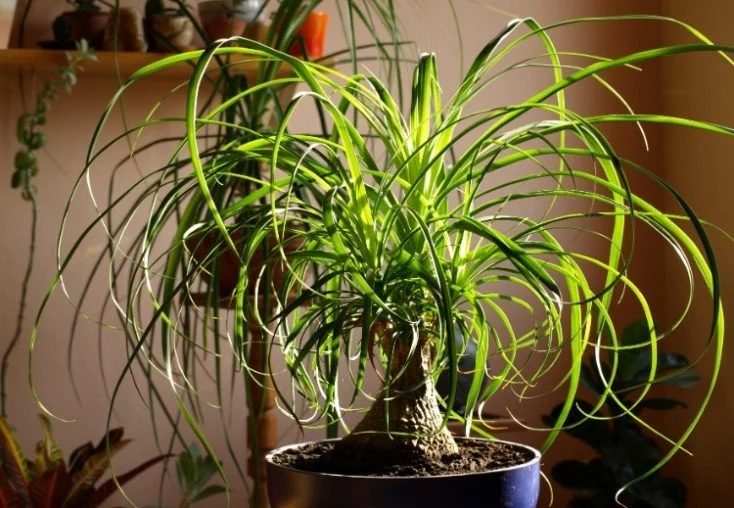- No products in the cart.
Are you interested in growing a palm tree in your home but concerned about the maintenance required to keep it hydrated through frequent misting and watering? If that’s the case, there’s a plant that might be perfect for you! The ponytail palm, scientifically known as Beaucarnea recurvata, boasts tropical foliage but can survive and flourish in a dry environment without the need for excessive moisture. This article will introduce you to the fascinating ponytail palm care and offer advice on how to cultivate it successfully indoors.
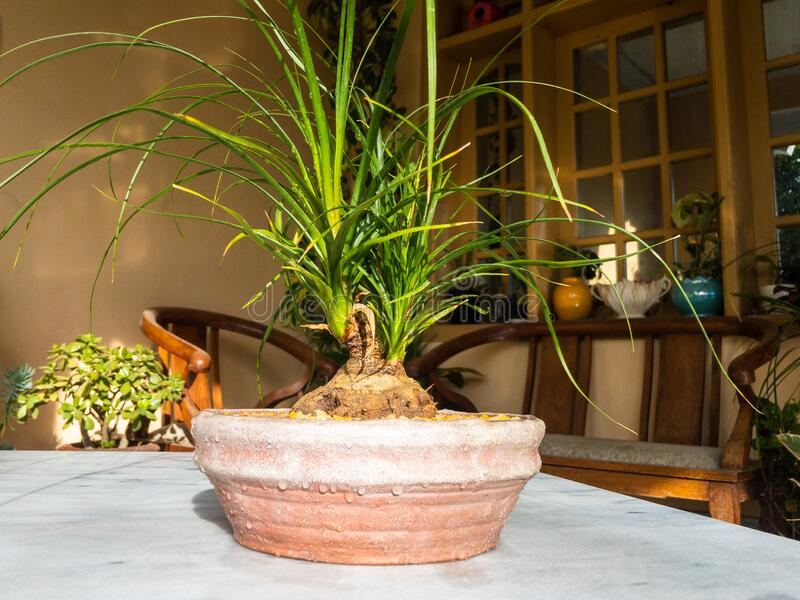
What exactly is the ponytail palm?
The ponytail palm, scientifically known as Beaucarnea recurvata, is not a true palm tree, but rather a succulent belonging to the Asparagaceae family, which also includes agave and asparagus.
While it is best suited for outdoor cultivation in warm and arid regions falling under the USDA Hardiness Zones 10 and 11, it is also a low-maintenance and attractive houseplant that thrives in all zones.
This plant is indigenous to semi-arid areas of southeastern Mexico and Central America, and is primarily known for its recurved evergreen leaves and caudex.
The caudex of the ponytail palm refers to the thickened, bulbous base of the plant’s trunk, which serves as a water storage organ. This unique growth habit is typical of caudiciform plants, which store water in their swollen bases. Because of its caudex, the ponytail palm is also referred to as the bottle palm tree and elephant-foot tree.
The ponytail palm typically has one or more trunks with branches that support the growth of serrated, recurved leaves. The unique downward and backward bend of these leaves creates a fountain-like display that resembles a ponytail. The leaves can vary in length, ranging from one to five feet long.
In its natural habitat, the ponytail palm can grow up to 30 feet tall. When grown in a pot, it usually reaches a maximum height of around four to eight feet. A large Beaucarnea recurvata growing in the landscape with pink flowers can be seen in a vertical close-up image.
Apart from the ponytail palm (Beaucarnea recurvata), the Beaucarnea genus consists of 12 other species. Among them, three species resemble the ponytail palm: the stiff-leaved Beaucarnea stricta, the slender and bluish-leaved Beaucarnea gracilis, and the red ponytail palm, Beaucarnea guatemalensis.
Cultivation and History of the Ponytail Palm
The ponytail palm, B. recurvata, was a wild tree in Mexico and southern regions until it caught the attention of plant hunters in the 1800s. They brought it to Europe for botanical study and development, and it became an established ornamental parlor plant by the late 1800s. Today, it remains popular in the United States.
However, the species is currently classified as threatened in its natural habitat and is found growing wild primarily in Veracruz, located in eastern Mexico.
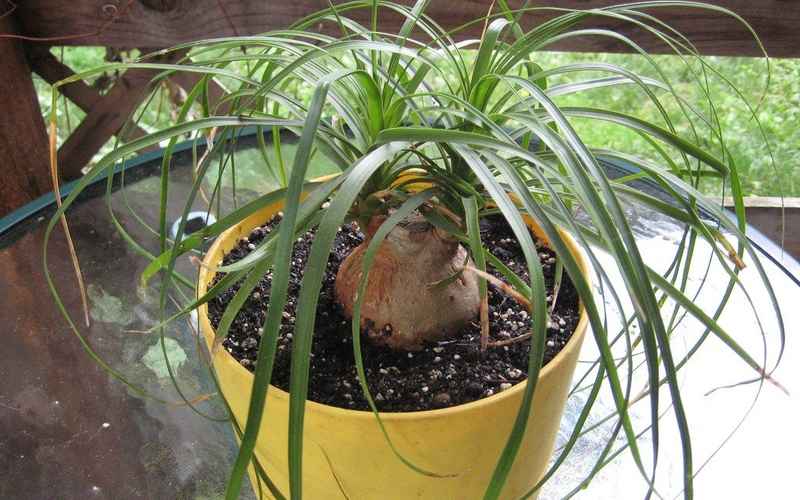
Propagation
Starting with a potted nursery plant is the easiest way to begin growing a ponytail palm. These plants can be found at local garden centers or purchased online. Another option is to start with an offset, which is cut from an existing plant, or with seed.
Offset Division
If you know someone who has a ponytail palm, keep an eye out for small offshoots, or “pups,” that grow from the main plant. Once these pups reach a height of at least four inches, they can be separated from the mother plant and transplanted for individual growing. Alternatively, they can be left in place for a multi-stemmed, multi-caudex specimen.
To separate a pup, you should first unpot the plant and gently lay it on its side. Using a sharp and clean knife, such as a hori hori, make a vertical cut between the mother plant and pup, going through the roots to separate them. After separating the pup, replant the mother plant, and plant the pup in a pot that is two inches larger than its caudex. Fill the pot three-quarters full with a well-draining cactus and succulent potting mix.
Starting a Ponytail Palm from a Potted Nursery Plant
Different sizes of nursery plants are available for purchase, with larger plants generally costing more due to the increased care they’ve received from professionals.
Before purchasing, it’s important to check if the roots are visible through the drainage holes at the bottom of the pot. If so, the plant may be “root bound” and require repotting.
While it may be tempting to keep the plant in its original plastic container, it’s better to transfer it to a porous container to promote proper air exchange and avoid oversaturation, which can be detrimental to this drought-tolerant plant.
Make sure to plant it at the same depth it was in the nursery pot when transferring it to a new container.
From Seed
Due to its restriction in a container, ponytail palm houseplants are unlikely to bloom, but outdoor female plants can set seed when successfully pollinated. If you want to sow seeds, start by gently scarifying them with an abrasive material like a nail file, then soak them overnight before planting.
Next, fill three-inch seed starter cells three-quarters full with a well-draining cactus and succulent potting mix. Sow one scarified, soaked seed per cell, at a depth of one-eighth of an inch.
Place the seeded cells on a tray near a bright window in a room with a temperature of around 70⁰F. You can also use a heat mat to maintain an even temperature.
Cover the seeded cells with a sheet of plastic wrap, but make sure it is loosely laid over them to allow air circulation. This creates a mini-greenhouse during germination and helps keep the potting mix moist. Water when the top of the soil is dry to the touch, but don’t let it completely dry out.
Expect sprouting to occur anywhere from three weeks to several months.
Once the seedlings have sprouted and grown multiple sets of true leaves, it’s important to remove the plastic wrap and water them when the soil surface dries out, but avoid overwatering.
When the seedlings have outgrown their starter cells, they need to be transplanted to larger pots. The ponytail palm likes to be snug in its container with only about two inches of space around it. Keep in mind that the size of the plant is influenced by the size of the pot it’s in – the smaller the pot, the smaller the plant.
When the roots start to protrude from the drainage holes, it’s time to move the plant to a larger pot to prevent it from becoming root-bound.
Ponytail Palm Care and Growing: Tips and Techniques
No matter how you begin growing your plant, it is crucial to use a loose and well-draining soil mix with a neutral pH level of 6.5 to 7.5.
Consider trying Espoma Organic Cactus Mix, which contains a patented blend of mycorrhizae that enhance nutrient and water uptake while retaining essential moisture without compacting the soil.
When choosing a pot, opt for a porous material like terra cotta or unglazed ceramic to prevent excessive moisture buildup that can lead to root rot.
Despite its palm-like appearance, this plant is adapted to arid environments and prefers a dry atmosphere like that of cacti and succulents.
To prevent leaf damage, place your plant in an area with bright, indirect light. Direct sunlight can be too intense and cause foliage to scorch, particularly through window glass.
Lastly, take a look at the horizontal close-up image of a small Beaucarnea recurvata (ponytail palm) growing in a pot near a window in a home.
B. recurvata grows best at around 70°F during the growing season and 50°F during winter dormancy. As temperatures warm up in late spring to early summer, houseplants can be moved outdoors but should be acclimated gradually to the outdoors by placing them in a sheltered location for a few hours each day for four to five days before placing them in the landscape or on the patio full-time.
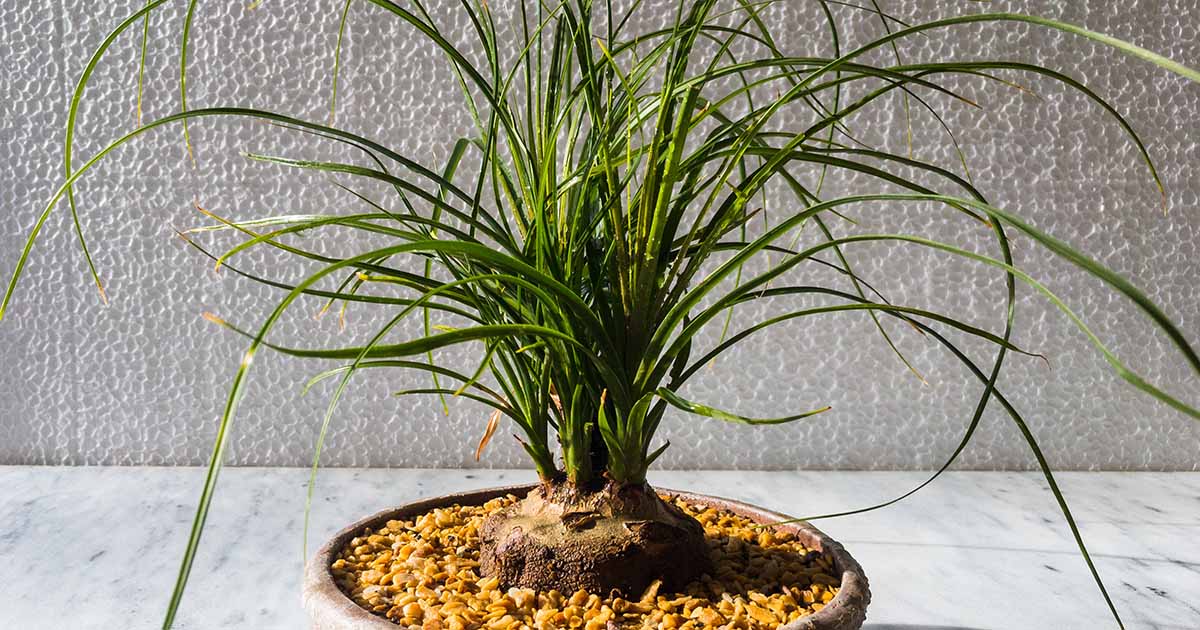
Outdoor plants benefit from fresh air, sunshine, and deep, soaking rain that keeps roots supple and able to absorb nutrients. However, in humid regions, it may be best to keep the plants indoors during summer to avoid diseases caused by excessive moisture.
Remember that ponytail palm is a cactus-like plant, and it is better to underwater than overwater. The caudex is an impressive water-storing structure that allows the plant to survive in semi-desert conditions, enduring drought and going several weeks without supplemental moisture.
When it comes to ponytail palm care, it is important to water it only when the soil has completely dried out since the last watering. If your houseplant is small enough to move, take it to the sink and water it until water runs out of the drainage holes to thoroughly saturate the roots. Water it a second time until the dripping stops to eliminate dry air pockets. Fertilize the plant with a liquid cactus and succulent plant food at planting time and in the spring.
Allow the plant to remain in a snug pot until the roots become root-bound and begin to peek out from the bottom of the pot. Repot in early spring, before the growing season begins, if the roots are crowded. On the other hand, if you prefer to encourage maximum growth, use a large pot that is at least two inches larger than the plant’s root system.
However, keep in mind that excess potting mix in a large pot may take a long time to dry out, leading to root rot. As the plant can reach eight feet in height, the pot may become too unwieldy to move, so a wheeled caddy may be necessary.
Adititional Ponytail Palm Care Tips
Here are some key points to remember for ponytail palm care and growing:
- Use a well-draining cactus and succulent potting mix that retains moisture but is not too compact.
- Place the plant in a location with bright, indirect sunlight and moderate temperatures to prevent leaf scorching.
- Water only when the soil has fully dried out and fertilize once at planting and annually in the spring.
- Repot only when the roots are severely bound, and do so in the early spring.
Pruning and Maintenance
The ponytail palm typically doesn’t require pruning, but if you notice brown tips or entire leaves, you may want to trim them off. When doing so, it’s best to cut as close to the point of origin as possible to avoid leaving partially cut stems that look uneven.
However, before you start pruning, it’s important to identify the source of the problem. Brown leaves can be caused by direct sunlight, or it could be a sign of underwatering or overwatering. Underwatered foliage tends to turn yellow and then brown, while excess moisture can cause the leaves to droop and turn yellow, with the trunk softening over time.
If you’re interested in experimenting with plant shaping, you may also want to try bonsai techniques on your ponytail palm.
If you are aiming to keep your ponytail palm small through bonsai, frequent feeding with plant food may promote growth and defeat the purpose of pruning. Instead, stick to fertilizing once a year in the spring and focus on selective pruning to maintain the desired size and shape.
Remember to also monitor the moisture level and avoid overwatering or underwatering, as these can lead to brown foliage that may need to be pruned.
Where to Buy Ponytal Palm?
It is easy to find potted ponytail palms for growing at home. You can purchase starter plants in six-inch pots or larger specimens in three-gallon containers from Prime Bonsai.
When purchasing from Prime Bonsai, you can expect thorough care instructions and guidance on ponytail palm care.
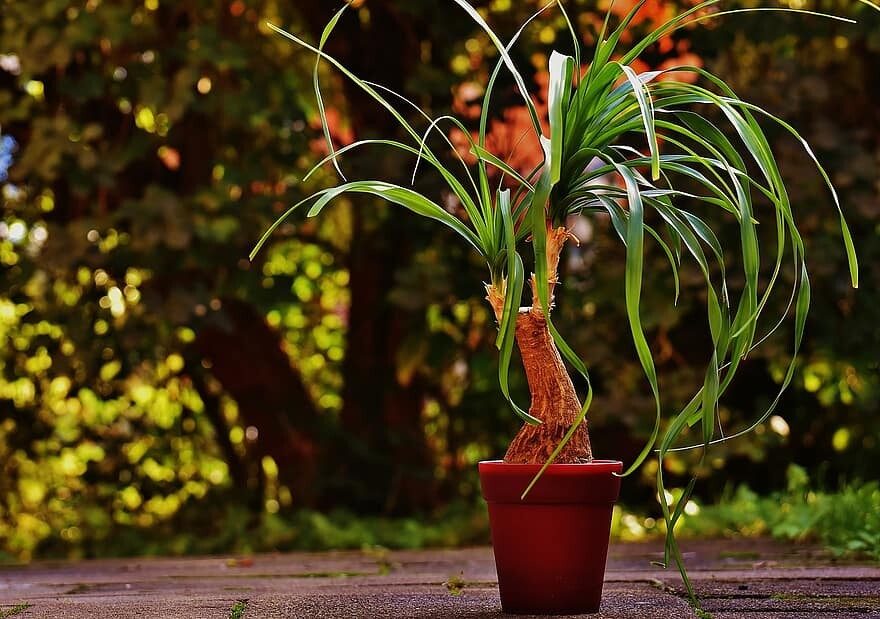
Controlling Pests and Diseases in Ponytail Palms
Container plants grown outdoors are generally less prone to pest and disease problems than houseplants. However, indoor ponytail palms can be more vulnerable, particularly when they are over or under-watered, or located in humid environments.
Some common pests that thrive in dry indoor conditions are mealybugs, scale, and spider mites. Fortunately, these pests can usually be controlled with organic neem oil if caught early.
There are also some diseases that may affect ponytail palms, such as bacterial leaf streak, Botrytis blight, and stem rot. These diseases are often worsened by high levels of humidity.
Why Should I Buy Ponytail Palms?
Long-lived, this ornamental species matures in about 10 years. By that time, it can withstand temperatures as low as 40°F. Avoiding frost exposure is essential for potted specimens taken outdoors in regions that freeze.
Have you always wanted to grow a palm, but don’t live in a warm zone for outdoor planting, nor do you want a houseplant that needs the thrice-weekly watering typical of many palms?
Give a ponytail palm a try!
While it’s not a true palm, the combination of tropical-style leaves and cactus-like moisture needs may be just what you’re looking for.
Add ponytail palm to your houseplant collection today and get ready to enjoy a fountain of evergreen foliage for decades to come.
Are you growing ponytail palm? Let us know in the comments section below – and feel free to share a picture!
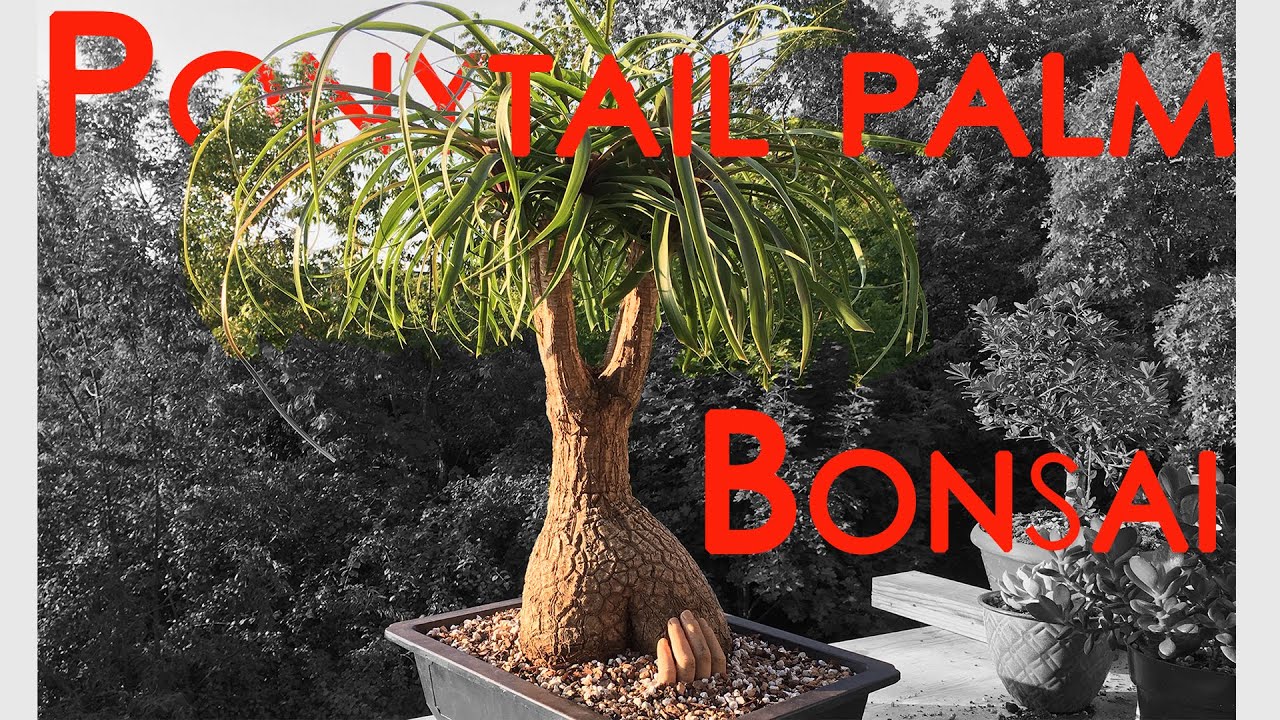
Growing Guide at a Glance:
| Plant Type: | Evergreen succulent | Hardiness (USDA Zone): | 10-11 |
| Native to: | Central America and southeastern Mexico | Exposure: | Bright, indirect light |
| Time to Maturity: | 10 years | Maintenance: | Low |
| Planting Depth: | 1/8 inch (seed), same depth as nursery pot (transplants) | Flower/Foliage Color: | Male: cream; female: pink / green |
| Height: | 4-8 feet | Soil Type: | Gritty, sandy |
| Spread: | 3-5 foot | Soil pH: | 6.0-7.5 |
| Growth Rate: | Slow | Soil Drainage: | Well-draining |
| Water Needs: | Low to medium | Order: | Asparagales |
| Common Disease: | Bacterial leaf streak, Botrytis blight, and stem rot | Family: | Asparagaceae |
| Common Pests: | Mealybugs, scale, spider mites | Genus: | Beaucarnea |
| Tolerance: | Drought | Species: | Recurvata |
If you enjoyed reading about ponytail palm care and would like to learn about more plants that can be grown and enjoyed indoors, we suggest the following:

